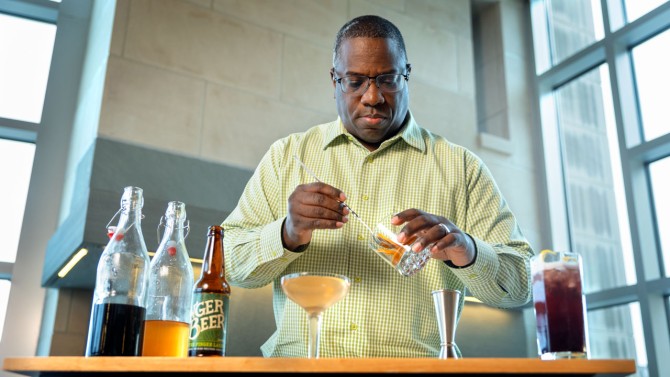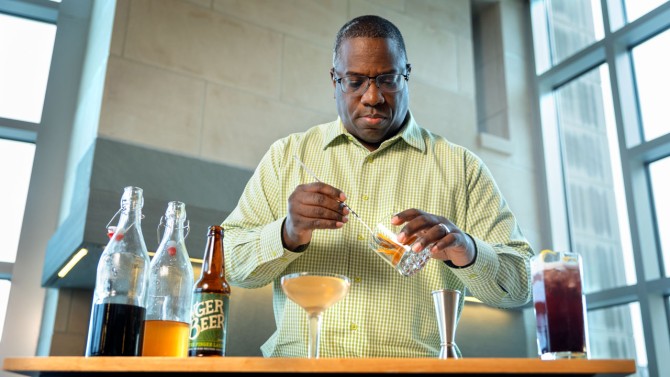Sophisticated Sips: Nonalcoholic Drinks with Complex Flavors Take Center Stage in New Year’s Eve Trends
New Year’s Eve partiers and restaurant-goers, especially millennials and Gen Zers, are more likely than ever to choose drinks without alcohol this holiday season.
“Nonalcoholic – it’s by far the top beverage trend right now. The numbers are huge,” said Cheryl Stanley ’00, senior lecturer in food and beverage management in the Cornell SC Johnson College of Business and instructor of Cornell’s iconic Introduction to Wines course. And she’s not talking about sodas, juices or the NA beers from 20 years ago.
The trend includes carefully crafted wine, beer, spirits and cocktails that lack alcohol by design, either through a removal process or because the beverage never had it in the first place. Everything from NA sparkling and still red, white and rose wine to whiskey, gin and prepackaged cocktails are now sold by the bottle, can or glass at prices comparable to their alcoholic counterparts. Although NA beverages make up a small percentage of the overall market, sales increased substantially over the past few years, according to industry data.
Stanley and Douglass Miller, also a senior lecturer in the SC Johnson College and an instructor of fermented beverage and restaurant management classes, recently shared their expertise on the Cornell Keynotes podcast, “Holiday Drinks to Dazzle Your Guests.”
With decades of complementary experience in the business – Stanley focuses on wine and spirits while Miller concentrates on beer, sake, cider and cocktails – the pair has been closely observing the rise of no- and low-alcohol drinks in the marketplace.
The growing interest in nonalcoholic drinks is partly related to the pandemic, Stanley said. Many people drank a lot during lockdown, and now they’re scaling back. But there’s more to it than that. First, “Dry January” arose with drinkers recalibrating after the holiday season each year. Then the movement extended to “Sober October.” Now, on any given night, people choose low or no-alcohol beverages for all kinds of reasons, whether it’s attention to health and wellness, observance of religious traditions, the need to stay sober for the drive home or any combination of factors.
The prevalence of nonalcoholic options on restaurant and bar menus is one clear sign that the trend is significant – and that the drinks are totally socially acceptable, Miller said.
“Even high-end top restaurants put together amazing nonalcoholic drink programs. If there wasn’t an audience, they wouldn’t be doing it,” he said. “And people are thoughtfully thinking through flavor profiles and using ingredients with complexities when making cocktails.”
Crafting a “sans cocktail” is a challenge because alcohol is not the focus, said Miller, who replaced the term “mocktail” and its negative connotation with the French word for “without.” But the process still requires the same creativity.
Miller, a winner of cocktail competitions, plays with uncommon ingredients, such as sumac, durian and soursop, which are available at markets and online. Bartenders, restaurateurs and hosts of home parties are experimenting, too.
One sans cocktail Miller developed combines the earthy herbaceous flavor of elderberry syrup with the sweetness of blackberry jam. A foam forms on top when it’s stirred, thanks to a natural stabilizing compound in the elderberry. Last fall, Establishment, the student-run restaurant at the Cornell Peter and Stephanie Nolan School of Hotel Administration, served the drink; it was crafted to honor the 50th anniversary of hip hop and named “Jam on it” for an early 1980s hit by the band Newcleus.
For those looking for beer, the options are “better than ever,” said Miller, who judged NA beers at last fall’s American Beer Festival. One example is a “hoppy amber” NA called Special Effects, sold by Brooklyn Brewery, co-founded by Stephen Hindy ’71.
For wine drinkers, Sovi Wine Co., founded by two graduates of the Samuel Curtis Johnson Graduate School of Management, Julia Littauer, MBA ’20, and Alex Littauer, MBA ’20, is one brand offering NA still and sparkling white and rose, and a still red, all sold in bottles or and cans.
In addition to nonalcoholic options, Stanley said consumers are also increasingly seeking lower-alcohol drinks. New low-alcohol dry white wines produced in New Zealand are becoming more popular, for example. Light lagers and pilsners are experiencing a resurgence. And home mixologists are making their favorite cocktails with NA spirits plus conventional vermouth.
“It’s so exciting,” Stanley said. “It makes for a more inclusive environment where everyone can participate.”


